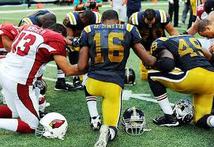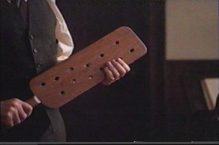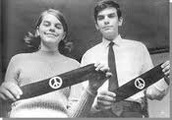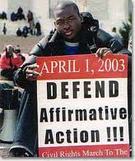The Three Branches of Government
Santa Fe Independent School District v. Jane Doe (2000)

*A Texas school district allowed students to lead a prayer over the public address system at football games. Some students and parents felt that this was a violation of their First Amendment rights.
*The Supreme Court ruled that these prayers were unconstitutional.
*The Supreme Court ruled that these prayers were unconstitutional.
New Jersey v. T.L.O (1985)

*Terry, a 14 year old freshman, was caught smoking in a school bathroom by a teacher. When the principal questioned her, he also asked to see her purse where he found cigarettes, rolling papers and a small amount of marijuana. Police were called and Terry admited to selling drugs at school. At court, Terry appealed this conviction claiming that the principal had performed unreasonable search and seizures, a violation of her Fourth Amendment protection.
*The Supreme Court ruled in favor of the schook, saying students should have privacy, however it must balance with schools responsibility for maintaining a learning environment.
*The Supreme Court ruled in favor of the schook, saying students should have privacy, however it must balance with schools responsibility for maintaining a learning environment.
Ingraham v. Wright (1997)

*James Ingraham, a 14 year old eighth grader, was taken into his principal's office after being disruptive in a school auditorium. His principaldecided to give him five swats with a paddle, however James claimed he had done nothing wrong and refused punishment. He was subsequently held down and the principal gave him 20 swats.
*The Supreme Court rulled against James. The Court said that reasonable physical discipline at school doesn't violate the Eighth Amendment of the Constitution.
*The Supreme Court rulled against James. The Court said that reasonable physical discipline at school doesn't violate the Eighth Amendment of the Constitution.
Tinker v. Des Moines Independent School District (1969)

*John and Mary Beth Tinker and their friend Chris Eckhardt wore black armbands to their school to protest the war in Vietnam. When school officials told them to remove the bands, they refused and were suspended. They sued the school district, claiming their First Amendment of freedom of speech was violated.
*The Supreme Court sided with the students, however the Court said that self-expression must be in balance with a school's need to keep order.
*The Supreme Court sided with the students, however the Court said that self-expression must be in balance with a school's need to keep order.
Grutter v. Bollinger (2003)

*1997, Barbara Grutter, a white Michigan resident, was denied admission to the University of Michigan Law School. She had a 3.8 undergraduate grade point average, and sued the university because they considered race in the admission process and that it violated her Fourteenth Amendment right of equal protection.
*The Supreme court upheld the use of affirmative action in higher education, saying "Student-body diversity is a compelling state of interest that can justify the use of race in university admissions."
*The Supreme court upheld the use of affirmative action in higher education, saying "Student-body diversity is a compelling state of interest that can justify the use of race in university admissions."
West Side Community Schools v. Mergens (1990)

*Bridget Mergens was a senior at Westside High School and had asked her principal if she could start an after school Christian club. The principal denied her request, saying it would be illegal in a public school.
*The Supreme Court ruled in favor of Bridget, saying that, "secondary-school students are mature enough and are likely to understand that a school does not endorse or support student speech that it merely permits."
*The Supreme Court ruled in favor of Bridget, saying that, "secondary-school students are mature enough and are likely to understand that a school does not endorse or support student speech that it merely permits."
Vernonia School District v. Acton (1995)

*James Acton, was a 12 year old seventh grader at Washing Grade School. His school required that athletes take drug tests on a random basis during the school year. Acton's parents refused to let him be tested and James was suspended from sports for the season. His parents sued the school district, claiming that drug testing was unconstitutional according to the Fourth Amendment.
*The Supreme Court ruled in favor of the school district saying, "Students who voluntarily participate in school athletics have reason to expect intrusions upon normal rights and privileges, including privacy."
*The Supreme Court ruled in favor of the school district saying, "Students who voluntarily participate in school athletics have reason to expect intrusions upon normal rights and privileges, including privacy."
Kent v. United States (1966)

*Morris Kent, 16, who was on probation since he was 14 for burglary and theft, was arrested and charged wit hthree home burglaries, three robberies, and two counts of rape. Morris's case was moved into adult case because of the severity of the charges and his crimnal history. He was found guilty and sentenced to 30-90 years in prison. Morris appealed saying that his case should have stayed in juvenile court.
*The Supreme Court rulled against Morris, saying that a minor can be tried and punished as an adult, but it depends on specific factors such as criminal history.
*The Supreme Court rulled against Morris, saying that a minor can be tried and punished as an adult, but it depends on specific factors such as criminal history.
Hazelwood School District v. Kuhlmeier (1988)

Cathy Kuhlmeier, Leslie Smart, and Leanne Tippett were juniors at their high school, and helped write the school newspaper. They wanted to include the issue of divorce on students and teen pregnancy in the next paper. The Principal refused to publish the stories, saying they were too sensative for younger readers and contained too many personal details. The girls went to court claiming their First Amendment right to freedom of speech was violated.
*The Supreme court ruled against the girls, saying that a school newspaper is not a place for everyone to voice their opinions, but rather for supervised learning.
*The Supreme court ruled against the girls, saying that a school newspaper is not a place for everyone to voice their opinions, but rather for supervised learning.
DeShaney v. Winnebago County Social Services (1989)

*Four year old Joshua DeShaney lived with his father who physically abused him. The State Department of Social Services took Joshua into custody and returned him to his father after three days. Later, Joshua was hospitalized with bruises over his body and severe brain damage. His mother sued the Department of Social Services for returning Joshua to his father, claiming his Fourteenth Amendment right was violated.
*The Court ruled against Joshua and his mother, saying that the Constitution does not protect children from their parents, and therefor the government is not at fault.
*The Court ruled against Joshua and his mother, saying that the Constitution does not protect children from their parents, and therefor the government is not at fault.
